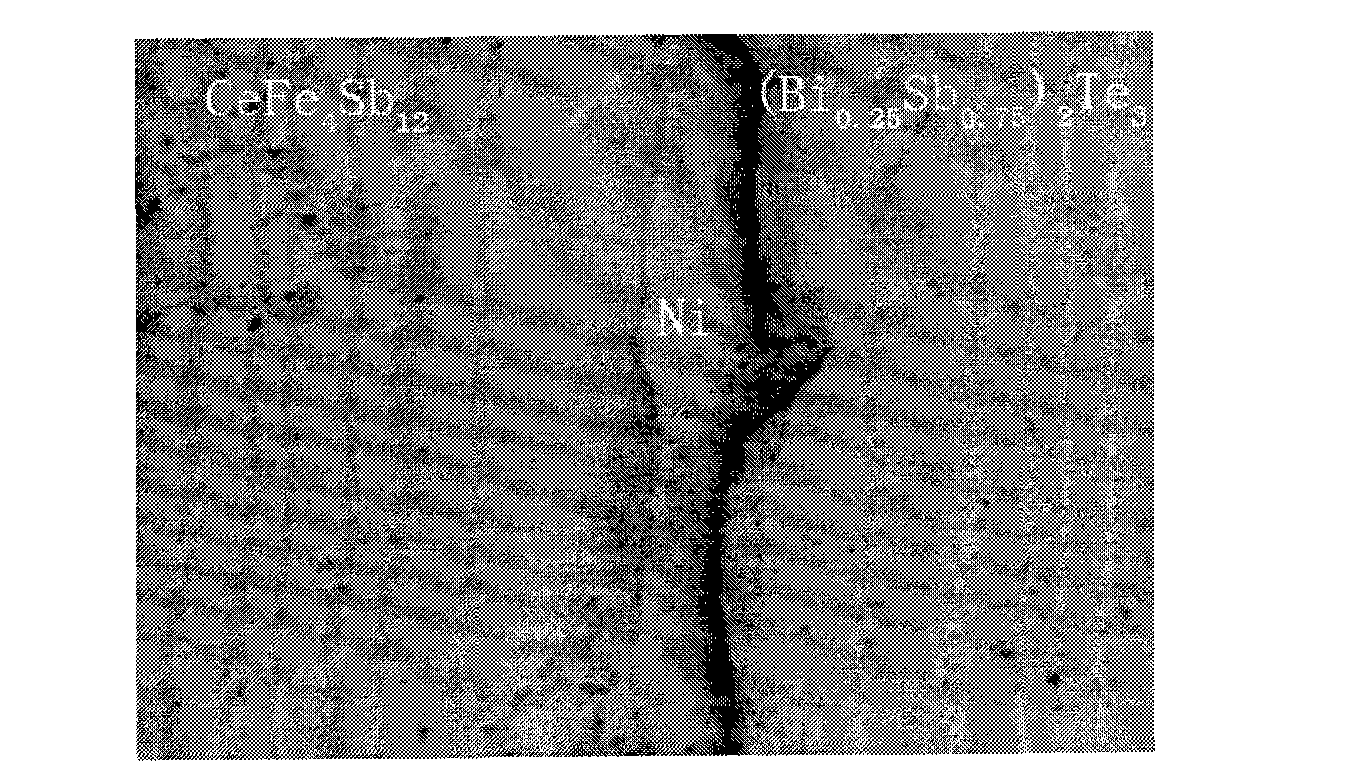P-type (Bi0.25Sb0.75)2Te3/CeyFe4Sb12(y=0.8-1.2)-based bulk gradient thermoelectric material and preparation method thereof
A thermoelectric material, 2te3 technology, applied in the direction of thermoelectric device node lead wire material, thermoelectric device manufacturing/processing, etc., to achieve the effect of simple sintering process and high bonding strength
- Summary
- Abstract
- Description
- Claims
- Application Information
AI Technical Summary
Problems solved by technology
Method used
Image
Examples
Embodiment 1
[0020] 1) Ce 0.8 Fe 4 Sb 12 The preparation of the block: the rare earth Ce and Fe simple substances according to the chemical formula Ce 0.8 Fe 4 Sb 12The measuring ratio is placed in an induction melting furnace, smelted four times under the protection of argon to make it uniform, and then crushed, sealed into a vacuum quartz tube together with Sb, and firstly heated from room temperature for 3 hours to 730°C and kept for 12 hour, and then continue to heat up to 900°C for 2 hours at a heating rate of 10°C / hour. Afterwards, quickly take it out and air cool to room temperature, and then anneal at 600°C for 3 days. The annealed ingot is taken out and crushed, and ball milled to obtain powder. Put the powder into the graphite mold and place it in the SPS sintering cavity, pressurize to 30Mpa under the vacuum condition of 5Pa, then raise the temperature to 600℃ for 5 minutes at a heating rate of 90℃ / min and sinter to obtain a block.
[0021] 2) (Bi 0.25 Sb 0.75 ) 2 Te ...
Embodiment 2
[0024] 1) CeFe 4 Sb 12 Preparation of powder: the rare earth Ce and Fe simple substances according to the chemical formula CeFe 4 Sb 12 The measuring ratio is placed in an induction melting furnace, smelted four times under the protection of argon to make it uniform, and then crushed, sealed into a vacuum quartz tube together with Sb, and firstly heated from room temperature for 3 hours to 730°C and kept for 12 hour, and then continue to heat up to 1000°C at a rate of 20°C / hour for 1 hour. After that, quickly take it out and cool it to room temperature, and then anneal at 600°C for 4 days. The annealed ingot is taken out and crushed, and ball milled to obtain powder. Put the powder into the graphite mold and place it in the SPS sintering cavity, pressurize to 40Mpa under the vacuum condition of 5Pa, then raise the temperature to 600℃ for 10 minutes at a heating rate of 120℃ / min and sinter to obtain a block.
[0025] 2) (Bi 0.25 Sb 0.75 ) 2 Te 3 Preparation of powder: ...
Embodiment 3
[0028] 1) Ce 1.2 Fe 4 Sb 12 Preparation of powder: the rare earth Ce and Fe simple substances according to the chemical formula Ce 1.2 Fe 4 Sb 12 The measuring ratio is placed in an induction melting furnace, smelted four times under the protection of argon to make it uniform, and then crushed, sealed into a vacuum quartz tube together with Sb, and firstly heated from room temperature for 3 hours to 730°C and kept for 12 hour, and then continue to heat up to 1000°C for 2 hours at a heating rate of 30°C / hour. Afterwards, quickly take it out and air cool to room temperature, and then anneal at 600°C for 5 days. The annealed ingot is taken out and crushed, and ball milled to obtain powder. Put the powder into a graphite mold and place it in an SPS sintering cavity, pressurize to 50Mpa under a vacuum of 5Pa, and then heat up to 600°C at a rate of 150°C / min for sintering for 10 minutes to obtain a block.
[0029] 2) (Bi 0.25 Sb 0.75 ) 2 Te 3 Preparation of powder: the co...
PUM
 Login to View More
Login to View More Abstract
Description
Claims
Application Information
 Login to View More
Login to View More - R&D
- Intellectual Property
- Life Sciences
- Materials
- Tech Scout
- Unparalleled Data Quality
- Higher Quality Content
- 60% Fewer Hallucinations
Browse by: Latest US Patents, China's latest patents, Technical Efficacy Thesaurus, Application Domain, Technology Topic, Popular Technical Reports.
© 2025 PatSnap. All rights reserved.Legal|Privacy policy|Modern Slavery Act Transparency Statement|Sitemap|About US| Contact US: help@patsnap.com



